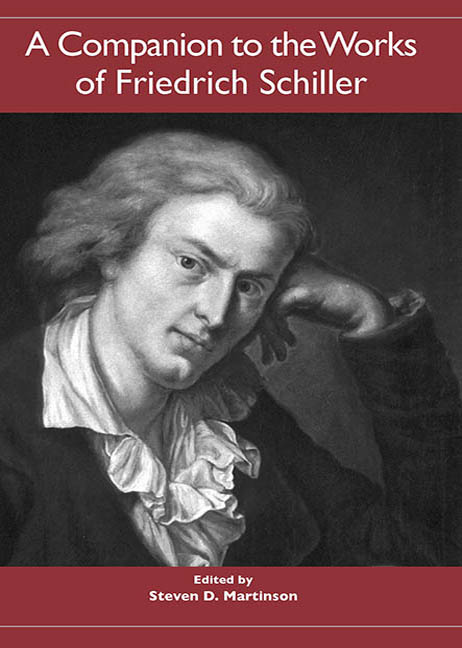Book contents
- Frontmatter
- Dedication
- Contents
- Acknowledgments
- The Works of Friedrich Schiller
- Editions and Abbreviations
- Introduction: Schiller and the New Century
- Intellectual-Historical Settings
- Major Writings
- Die Räuber: Structure, Models, and an Emblem
- Kabale und Liebe Reconsidered
- Great Emotions — Great Criminals?: Schiller's Don Carlos
- Concerning Aesthetic Education
- “On the Shores of Philosophy”: Schiller's Lyric Poetry, 1795
- Wallenstein
- Maria Stuart: Physiology and Politics
- Die Jungfrau von Orleans
- Wilhelm Tell
- Schiller's Legacy
- Works Cited
- Notes on the Contributors
- Index
Kabale und Liebe Reconsidered
from Major Writings
Published online by Cambridge University Press: 28 April 2017
- Frontmatter
- Dedication
- Contents
- Acknowledgments
- The Works of Friedrich Schiller
- Editions and Abbreviations
- Introduction: Schiller and the New Century
- Intellectual-Historical Settings
- Major Writings
- Die Räuber: Structure, Models, and an Emblem
- Kabale und Liebe Reconsidered
- Great Emotions — Great Criminals?: Schiller's Don Carlos
- Concerning Aesthetic Education
- “On the Shores of Philosophy”: Schiller's Lyric Poetry, 1795
- Wallenstein
- Maria Stuart: Physiology and Politics
- Die Jungfrau von Orleans
- Wilhelm Tell
- Schiller's Legacy
- Works Cited
- Notes on the Contributors
- Index
Summary
Begun by Schiller in 1782 and first performed in Frankfurt on April 15, 1784, then two days later in Mannheim, Kabale und Liebe (Intrigue and Love) has ever since remained in the repertory and been a staple offering of German theater. Through three centuries, it has been Schiller's most performed play (Fischer, 34). Even today, and as a glance in publications like Der Spiegel, Schaubühne, and Theater heute will confirm, it continues to be one of the playwright's most popular dramas. Though many have loved it, not all audiences have been so taken with Kabale und Liebe. Even contemporary critics found fault with the play, and point to serious shortcomings in their reviews. Initial critical responses raise objections to inane dialogue and melodramatic exaggeration. Such criticisms cannot be denied. Luise's urgent plea to her beloved Ferdinand von Walter, for instance — “Sieh mich an, lieber Walter. Nicht so sehr in die Zähne geknirscht” — sounds more silly than serious, as was actually intended.
Latter-day scholars likewise acknowledge major artistic flaws. Most notably, Erich Auerbach in his now-classic study of the Western literary tradition describes and dismisses Kabale und Liebe as “a tempestuous, an inspired and inspiring, a very effective, and yet — when we look at it a little more closely — a fairly bad play. It is a melodramatic hit written by a man of genius” (441). As Benno von Wiese observes, “Wohl wird dem Zuschauer etwas zuviel zugemutet, wenn der sterbende Ferdinand am Ende doch noch ‘dem zerschmetterten’ Vater vergibt” (217). More recently, Bernd Fischer calls attention to the weak ending, where Schiller waffles between total tragedy and a restoration of order and intimation of harmony (97). As Fischer also points out, the heroine occasionally falls out of character, for instance in her pivotal meeting with Lady Milford (130). In a deft summary of the play's problems, Walter Pape argues that it presents exaggerated and psychologically untrue characters and that the work ends with an unnecessary catastrophe (199). Even so, Kabale und Liebe remains exceedingly popular, a perennial favorite, and still draws an audience.
- Type
- Chapter
- Information
- A Companion to the Works of Friedrich Schiller , pp. 115 - 136Publisher: Boydell & BrewerPrint publication year: 2005



